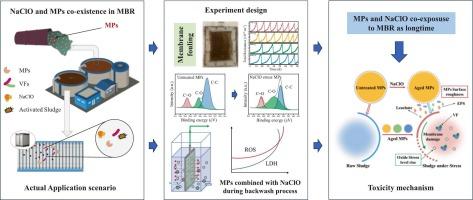NaClO changes metabolic pathway by regulating oxidative stress and virulence of microplastics to activated sludge in MBR
IF 9
1区 工程技术
Q1 ENGINEERING, CHEMICAL
引用次数: 0
Abstract
Microplastics (MPs) and NaClO were both prevalent in MBRs, and their coexistence poses a potential threat to nitrogen biotransformation in wastewater treatment systems. However, investigations on how MPs combined with NaClO affect the microbial nitrogen conversion and metabolism of the activated sludge are still scanty. In this study, the MPs or NaClO exposure alone had marginal impacts on the nitrogen removal in MBRs, while the two pollutants' coexistence in MBR, the total nitrogen removal efficiency decreased from 83.59 % to 74.46 % by the suppression of nitrogen transformation processes. Metagenomic analysis revealed that the abundance of functional genes encoded by key enzymes related to nitrogen transformation, including nirK, norB, nosZ and nirS, were also decreased with MPs and NaClO co-exposure. The reason for the above phenomenon may be the biotoxicity of MPs to activated sludge caused by NaClO, the ROS production increased to 128.57 % with MPs and NaClO co-exposure. The increase of intracellular oxidative stress level and virulence factors synthesis confirmed that NaClO can aggravate the toxicity of MPs to activated sludge. The increased toxicity of MPs to activated sludge caused by NaClO may be attributed to the oxidation of MPs, that is, the change of functional groups. This study provides vital insights into the responses of microbial community structure and nitrogen conversion processes to interference MPs combined with NaClO backwash agent residual in MBRs.

NaClO通过调节MBR中微塑料对活性污泥的氧化应激和毒力改变代谢途径
微塑料(MPs)和NaClO在mbr中普遍存在,它们的共存对废水处理系统中的氮生物转化构成潜在威胁。然而,关于MPs与NaClO结合对活性污泥微生物氮转化和代谢的影响的研究仍然很少。在本研究中,单独暴露MPs或NaClO对MBR的脱氮影响较小,而两种污染物在MBR中共存时,通过抑制氮转化过程,总脱氮效率从83.59 %下降到74.46 %。宏基因组分析显示,mp和NaClO共暴露后,与氮转化相关的关键酶编码的功能基因(nirK、norB、nosZ和nirS)的丰度也降低。产生上述现象的原因可能是nacl对MPs的生物毒性作用,MPs与NaClO共暴露时,活性氧产量增加到128.57 %。细胞内氧化应激水平和毒力因子合成的增加证实了NaClO可加重MPs对活性污泥的毒性。NaClO导致MPs对活性污泥的毒性增加可能是由于MPs的氧化,即官能团的改变。该研究为mbr中微生物群落结构和氮转化过程对干扰MPs联合NaClO反洗剂残留的响应提供了重要的见解。
本文章由计算机程序翻译,如有差异,请以英文原文为准。
求助全文
约1分钟内获得全文
求助全文
来源期刊

Separation and Purification Technology
工程技术-工程:化工
CiteScore
14.00
自引率
12.80%
发文量
2347
审稿时长
43 days
期刊介绍:
Separation and Purification Technology is a premier journal committed to sharing innovative methods for separation and purification in chemical and environmental engineering, encompassing both homogeneous solutions and heterogeneous mixtures. Our scope includes the separation and/or purification of liquids, vapors, and gases, as well as carbon capture and separation techniques. However, it's important to note that methods solely intended for analytical purposes are not within the scope of the journal. Additionally, disciplines such as soil science, polymer science, and metallurgy fall outside the purview of Separation and Purification Technology. Join us in advancing the field of separation and purification methods for sustainable solutions in chemical and environmental engineering.
 求助内容:
求助内容: 应助结果提醒方式:
应助结果提醒方式:


